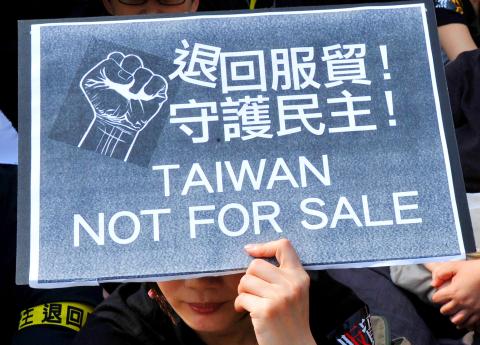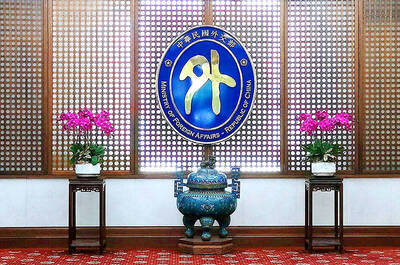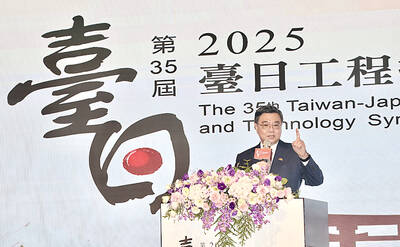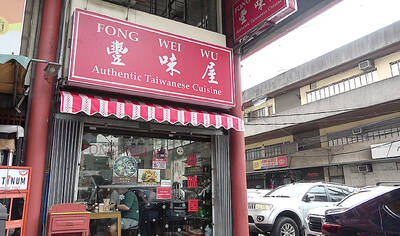As a student-led protest against the government’s handling of the cross-strait service trade agreement continues, the Ministry of Economic Affairs (MOEA) is planning to hold presentations at universities to explain to students the government’s views on the controversial accord.
Vice Minister of Economic Affairs Woody Duh (杜紫軍) is to head a team assigned to address the pact at schools, with his maiden show scheduled to take place at National Chengchi University today, followed by a second presentation at National Taipei University tomorrow.
During the presentations, Duh will explain what the services trade accord is, its contents and why it was signed, the ministry said.

Photo: Mandy cheng, AFP
Duh said he will also detail the signing process, which took place in June last year, and the pact’s legislative review and ratification process.
To avoid possible criticism blasting the presentations as nothing more than government propaganda, he will be open to questions, Duh said, adding that he is ready for any “thorny” questions.
It will be the ministry’s first presentation of the trade pact on campuses since the start of protests against the government’s handling of the accord on March 18 after Chinese Nationalist Party (KMT) lawmakers tried to fast-track it and put it to a full vote on the legislative floor, bypassing the review process.
The protest has since been expanded to an occupation of the Legislative Yuan by student protesters.
Concerned that the agreement, under which the two sides agree to open up to each other’s service sectors, would hurt Taiwan’s businesses and job market, protesters are demanding new legislation that would subject any cross-strait agreement to close monitoring by legislators and that lawmakers refrain from taking any action on the pact until the new law is enacted.
The ministry said that on Aug. 9 last year, it mailed 454 law, economics and finance departments and institutes at universities around the nation, asking if they wanted to have the government’s presentation of the services pact organized on their campuses.
However, most schools, including National Taiwan University and National Tsing Hua University, showed a lack of interest in the proposal, it said.
In other developments, the Formosa Plastics Group (FPG) responded positively to President Ma Ying-jeou’s (馬英九) press conference on Saturday addressing student protesters’ demands over the service trade pact and called for its quick passage through the legislature to help Taiwan gain greater access to the global economic community.
FPG said Ma gave clear explanations to assuage the doubts of the protesters and the public about the pact and cited central bank Governor Perng Fai-nan (彭淮南) as saying that “signing free-trade agreements always involves some give and take.”
If the agreement fails to clear the Legislative Yuan, Taiwan will not be able to conclude its negotiations on the largely completed goods trade agreement, which FPG said would hamper the nation’s efforts to join the proposed Trans Pacific Partnership and the Regional Comprehensive Economic Partnership.
Should this be the case, it will be extremely difficult for Taiwanese manufacturing businesses that are already squeezed by slim profit margins to survive, the group said.
FPG, one of Taiwan’s largest conglomerates with diverse interests, also urged the government to help tide businesses affected by the pact until progress is made.

The Ministry of Foreign Affairs (MOFA) yesterday voiced dissatisfaction with the Comprehensive and Progressive Agreement for Trans- Pacific Partnership (CPTPP), whose latest meeting, concluded earlier the same day, appeared not to address the country’s application. In a statement, MOFA said the CPTPP commission had "once again failed to fairly process Taiwan’s application," attributing the inaction to the bloc’s "succumbing to political pressure," without elaborating. Taiwan submitted its CPTPP application under the name "Separate Customs Territory of Taiwan, Penghu, Kinmen and Matsu" on Sept. 22, 2021 -- less than a week after China

ALIGNED THINKING: Taiwan and Japan have a mutual interest in trade, culture and engineering, and can work together for stability, Cho Jung-tai said Taiwan and Japan are two like-minded countries willing to work together to form a “safety barrier” in the Indo-Pacific region, Premier Cho Jung-tai (卓榮泰) yesterday said at the opening ceremony of the 35th Taiwan-Japan Modern Engineering and Technology Symposium in Taipei. Taiwan and Japan are close geographically and closer emotionally, he added. Citing the overflowing of a barrier lake in the Mataian River (馬太鞍溪) in September, Cho said the submersible water level sensors given by Japan during the disaster helped Taiwan monitor the lake’s water levels more accurately. Japan also provided a lot of vaccines early in the outbreak of the COVID-19 pandemic,

Kaohsiung Mayor Chen Chi-mai (陳其邁) on Monday announced light shows and themed traffic lights to welcome fans of South Korean pop group Twice to the port city. The group is to play Kaohsiung on Saturday as part of its “This Is For” world tour. It would be the group’s first performance in Taiwan since its debut 10 years ago. The all-female group consists of five South Koreans, three Japanese and Tainan’s Chou Tzu-yu (周子瑜), the first Taiwan-born and raised member of a South Korean girl group. To promote the group’s arrival, the city has been holding a series of events, including a pop-up

A home-style restaurant opened by a Taiwanese woman in Quezon City in Metro Manila has been featured in the first-ever Michelin Guide honoring exceptional restaurants in the Philippines. The restaurant, Fong Wei Wu (豐味屋), was one of 74 eateries to receive a “Michelin Selected” honor in the guide, while one restaurant received two Michelin stars, eight received one star and 25 were awarded a “Bib Gourmand.” The guide, which was limited to restaurants in Metro Manila and Cebu, was published on Oct. 30. In an interview, Feng Wei Wu’s owner and chef, Linda, said that as a restaurateur in her 60s, receiving an